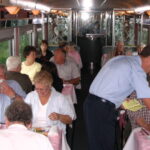Regulation: Some Good, Some Not.
The argument for and against government regulation goes on. And on. And on. What I object to is the knee jerk reaction by conservatives who oppose any new regulation simply as a matter of ideology. No doubt some government regulation is overblown and intrusive. Maybe even unnecessary. But most is sensible and needed. (By the way, what is it about the phrase “well regulated” in the Second Amendment that the National Rifle Association and their supporters don’t understand?)
 Surely we need to regulate the pharmaceutical companies to be sure we’re not paying outrageous prices for pills that don’t work or are unsafe. And do we really want the “free market” to self-regulate when it comes to the food we eat? And shouldn’t there be oversight and regulation in the transportation industry … the airlines, for instance? Don’t we want the FAA keeping an eye on things?
Surely we need to regulate the pharmaceutical companies to be sure we’re not paying outrageous prices for pills that don’t work or are unsafe. And do we really want the “free market” to self-regulate when it comes to the food we eat? And shouldn’t there be oversight and regulation in the transportation industry … the airlines, for instance? Don’t we want the FAA keeping an eye on things?
Here’s the related question of the day: how many people should operate a train? In the days of steam engines, there were two people in every locomotive cab, an engineer and a fireman. The arguments began when diesel locomotives replaced the steam engines. Why, management asked, do we still need two people in the head end? For safety reasons, replied the Federal Railroad Administration, the government entity that—here’s that word again—regulates the railroads.
But now that issue has gotten a bit more complicated. Following a deadly collision in 2008, the FRA mandated the implementation of Positive Train Control systems (PTC). Using global positioning and computers and track-side signals, PTC will supposedly override human error and prevent accidents.
Now that we’re within a couple of years of having PTC in place, the Association of American Railroads, on behalf of their membership, is questioning the FRA’s mandate that there be two people in every locomotive cab. With PTC in place, says the AAR, one engineer should be enough.
It’s a legitimate question, and you can bet that Amtrak is interested in this issue since they are in their perpetual and enforced cost-cutting mode. Still, as a frequent Amtrak passenger, when I’m tucked in and settling down for the night in my roomette, as the Southwest Chief rolls along across Kansas at 79 miles an hour, I think I’d sleep more comfortably knowing that there are two engineers up there in the head end.



I don’t know. A second driver might be, on the contrary, a possible distraction, more than a safety guard. In Europe, only Italy mandates a second driver, if I remember correctly, the others use just one driver and the safety system. But most trips aren’t so long as in the US, where the 2 drivers generally have different starting moments, again, if my memory isn’t failing, so they probably won’t be tired at the same moment.
As far as I know, on the long-distance trains, the whole Amtrak crew comes on and goes off duty at the same time–two engineers and two conductors. There is just one person in the head end of trains running on the Northeast Corridor. Frankly, I’m not sure about other eastern trains. The Maple Leaf, for example (New York to Toronto). It’s roughly a 9 1/2-hour ride from New York City to the Canadian border. One engineer or two? I’m not sure, but will find out. Thanks for the feedback.
I might be wrong, I once read an accident report in Canada, and that was one of their recommendations. Not sure it was implemented, though, and Canada is not the US, either.